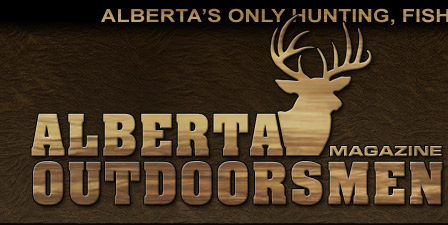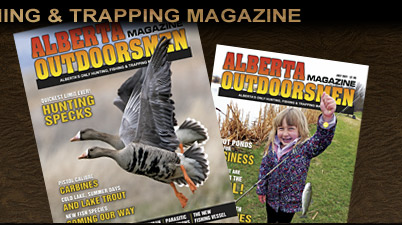|
 |
“Dan! Go to the northeast point and crouch behind those red willows, just outside the main bush. Erik and Rafe, push parallel to one another going north and hold short of coming out in the open until you see Dan stand up. Bruce, go to your lucky spot half way down the east side and stay next to the fence. We’ll call you when the push is over. Jerry and I’ll take the truck and position ourselves on the northwest side near the hay bales.”
Sound familiar? If you are a deer hunter from the Prairies, it may. It’s the orders from the huntmaster to his “gang” about to start a deer drive. I have hunted this way for over 20 years, as did my dad and his gang for 20 years before me.
Until recently, there were very few articles published about this effective tactic in whitetail hunting in the Prairies. Perhaps it was taken for granted that everyone knew of the system.
Unlike the highly skilled still-hunter, especially bowhunters, who use tree stands or ground blinds, work small areas of woods, and know the movements of the local deer, the “push and bush” tactic is relatively primitive. It entails four or more hunters organized into two groups. The “pushers” walk through designated areas to be hunted in a certain direction and in a prescribed time, supposedly forcing the deer toward the “pointers” who wait in ambush. The hunting terrain has to be familiar, and known escape routes for the deer are an added bonus; usually learned from previous “pushes” of the same area. In a single day, four to six hunters working several different areas can move dozens of deer.
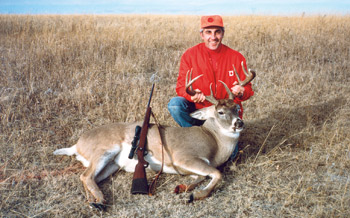 |
| "This nice whitetail buck was pushed out of a coulee and tried to make a break across a grassy field before the author’s bullet found its mark." |
The beauty of this type of hunting is that the pushers kept warm as they fought through the underbrush to their assigned spots. The guys on point waited in keen anticipation for the deer to come busting out towards them. The disadvantages are that the good pushers rarely got a chance for a shot if they worked the densest part of the bush. Sometimes they completed the push soaking wet with perspiration from traversing the seemingly impassable wooded areas they had to negotiate in a specific time allotment. The push had to be well orchestrated to be effective. Guys who got lost easily in small woodlots or couldn’t be relied upon to do their assigned task just weren’t asked again to join the gang on the next hunt.
On the other hand, the persons on point could get freezing cold if the push was a long one and/or the weather was subzero. However, the “man on point” had to be an excellent running shot to bag his animal.
We practiced each winter shooting released balloons across open fields and hunting jackrabbits, coyotes and foxes. We all became expert at running shots and rarely missed.
The deer always came out like freight trains at full throttle and would head for the next bush or ravine. Using a .270 Win. or .257 Roberts handloaded with bullets having muzzle velocities of 3,000 f.p.s. were just great to 450 yards. Deer going flat out across a stubble field needed about four deer lengths of lead at distances of 200 to 300 yards. Some spectacular hits and misses would be witnessed by the gang when they regrouped after the push. Late arriving pushers, improperly positioned pointers, and poor marksmanship were severely criticized. Sometimes tempers would flare, but the camaraderie was fantastic and these differences were forgotten, as the huntmaster quickly got everyone in a huddle and spelled out the next push, diagramming the logistics on the ground with a stick or cartridge.
Each gang had a name and was composed of the same individuals year after year. They had their own territories and an unwritten rule was not to invade the areas hunted by another gang. However, when one gang was short of some members or when a large section of bush was to be pushed, prior arrangements were made to amalgamate everyone into one unit. Such a large group could number 15 hunters or more and the result could be catastrophic chaos or, more often, every deer that was driven was shot. The hunting was a highly organized affair not allowing for too much individuality.
I especially remember one specific drive. The man on point fired a single round at one of two whitetail bucks as they bolted out of the bush. Both bucks hit the ground. The 130-grain .270 bullet had gone clean through the chest of the first buck without hitting any bone and lodged in the shoulder of the second buck. There were only two whitetail tags left in the gang, his and mine.
We didn’t want to leave the second buck to waste so I put my tag on the deer. That ended my whitetail hunting that fall. I did have a mule deer tag so I concentrated on the area I knew they inhabited. As luck turned out, I shot the largest mule deer buck I had ever seen the next day.
The second time we ever got a 2-in-1 shot was the previous year. I waited it out while two large coyotes that were flushed from a ditch crisscrossed in front of each other as they ran away. The third time they crossed, I squeezed off and both ploughed into the frost-covered stubble field.
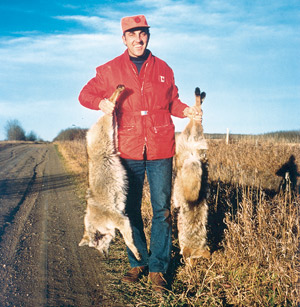 |
| “Rare, but not unheard of, two-in-one shots on deer and coyotes are possible.” |
After a week or so of pushing the bush, your back and leg muscles really get in shape. Another bonus of the system is flushing coyotes that frequent the same stands of cover. They almost always took a course straight away from the pushers and rarely sneaked back around them or exited the side of the bush. We found that shooting at them did not affect the outcome of any deer in the drive. They provided an excellent target for running shots and their skins made an excellent coat for one of the guys while I had a large bedspread made from 22 of my prime pelts. If you could nail one on the full run at 200 yards, any deer to 300 yards was a comparatively easy shot. The only drawback during the hunt to bagging coyotes was the temporary delay it caused while the animal was being skinned. The guys who hadn’t shot a deer or coyote yet would give the lucky hunter a hard time while he hurriedly “undressed the dog”.
The main limiting factor to hunt an area was to get permission to set foot on it. I usually went a day or two before the rifle season opened and visited all the farmers who owned land in the areas we wanted to hunt. I am not a very diplomatic person, but in my favour was asking for permission before the season opened and, being of Ukrainian origin, I was able to converse with the Ukrainian farmers. I still got plenty of no’s but we did respect the landowner’s rights and had to pass up some prime hunting areas. In most cases, I obtained permission on the first visit but if it was refused, I sometimes returned the next year for a second try. Telling the landowner that his neighbour allowed me access sometimes convinced him to give in.
The pitfalls were, firstly, never talk to the wife of the farmer and, secondly, don’t ask for permission from a person who is renting land from a person who is renting land from an “owner” who lives in “the city”. In both cases, they abrogate their responsibilities, although they both have the legal right to give you access to their properties.
Once when I was denied access the reason was, “the hunter cut the fence, drove into the field, did his shooting, and left. Our cattle then exited through the hole in the fence and it took three days to round them up.”
“Who was the hunter?” I asked.
“The next door neighbour,” was the answer. I still wasn’t given permission, no matter how I tried to explain that I wasn’t a neighbour. A third reason for being denied access was that the farmer himself was a hunter and in many cases a poacher. Many told me they already had their deer in the freezer before the season opened.
On one occasion, I walked into the barn to speak with the landowner and found him skinning out six deer. He reached for his gun when I entered but returned it against the cutting table when he saw I was dressed in the telltale blaze orange of a hunter. Next to the door was his truck, a WW II Lancaster bomber search light mounted on the top of the cab.
Most of the poaching was done at night by the local residents of towns and adjacent farms and not by the “city slickers”. They drove the edges of grain fields catching the deer feeding in the stubble with high intensity spotlights that blinded the deer and the killing was easy. If the deer did not drop in its tracks immediately when it was hit but jumped back in the bush, the poachers rarely tracked it. Our gang found several such dead deer while pushing the bush.
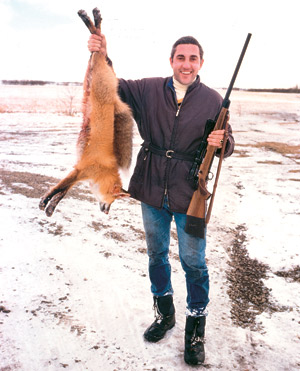 |
| “Red foxes are among the fastest running game, especially when the snow is firm and crusty.” |
After our supper at the end of the day’s hunt, we often hit small town bars. The long faces of dejected and deerless hunters were quickly recognized by persons in the bar who had a deer too many “stashed behind the barn”. When we finally left the bar, they would be waiting outside for us. In the 60’s, an entire big whitetail buck went for $25.00. Now the poachers are demanding astronomical prices but only for the horns; the meat is left to rot. When you read about biologists guesstimate one-half the deer killed per year are poached, I believe them.
Camp Wainwright on the eastern border of Alberta is a restricted area run by the military. It does allow a certain number of hunters at specific times to hunt if they are successful in a special draw. Back then, all
animals bagged were to be taken to a designated building where biologists would weigh the animals and take organ samples, etc. Here is where I met some of the finest deer researchers in the world and learned a lot from them. Through them, I was able to get a microscopic analysis of a mule deer doe I had shot and done a post-mortem on. The belly of the deer contained a large cauliflower tumor and there was cancer spread to the bones and lungs. She acted normal and could jump fences with ease during the push. Under a thick hide was at least two inches of solid fat. The tumor turned out to be a cancer of the ovary.
A successful hunt in Camp Wainwright was a bonus for the freezer. We tried our best to go for the bucks but a big fat grain-fed mulie doe was still a prize. In the early morning, we broke up into two’s to still-hunt for an hour or so before rejoining the gang. My partner and I were glassing a bluff adjacent to the western edge of the camp hoping to see deer moving due to hunter activity to the east. Sure enough, a big mulie doe came out, stopped, and then looked behind her. This gave us enough time to get into the kneeling position and we both fired simultaneously. The deer took one step and dropped dead. We both cried out, “I got it!” Walking toward the downed animal, the debate as to whom the kill would be awarded began. It wasn’t until a week later that the animal was butchered, a single bullet hole was found, and the bullet recovered. My partner was shooting a .270 and I had a .257 Roberts. The milked bullet measured .257.
In all the years I have deer hunted, I have never seen a firearm related accident. We always approached one another with open bolts and never had a loaded firearm in a vehicle. When the man on point saw a deer come out of the bush, he waited until it was in the clear so as not to shoot into the bush towards the advancing pushers.
Times change and after 20 years my gang has broken up. One member moved to England, another died, while one joined another gang, and I moved to the West Coast. Two are still hunting together and occasionally join a large gang to push big sections of bush in the region we used to hunt. I shall never forget the camaraderie and the wonderful and exciting days hunting the elusive whitetail on the Prairies. ■
For previous Reader Stories click here.
|
|
|
|

